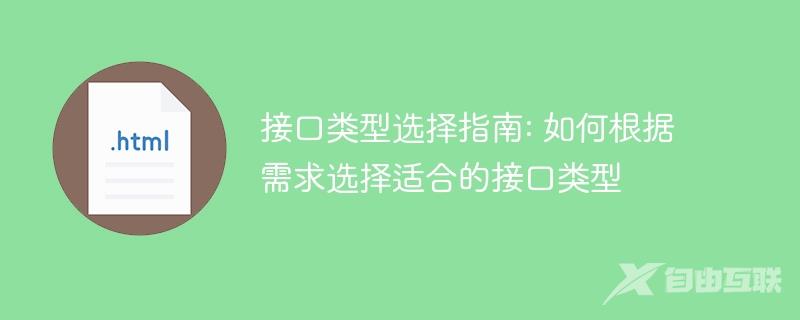
接口类型选择指南: 如何根据需求选择适合的接口类型,需要具体代码示例
导言:
在开发软件中,接口是不可或缺的组成部分。选择适合的接口类型对于软件的功能和性能是至关重要的。本文将介绍几种常见的接口类型,并提供代码示例,帮助读者根据实际需求进行选择。
一、同步接口:
同步接口是最常见的接口类型之一,它在发送请求后等待接收到响应后才能继续执行。同步接口通常用于需要实时反馈结果的场景,例如查询数据、提交表单等。以下是一个使用同步接口的示例:
import requests
def get_user_info(user_id):
url = f"https://api.example.com/user/{user_id}"
response = requests.get(url)
if response.status_code == 200:
return response.json()
else:
return None
user_info = get_user_info(123)
if user_info:
print("用户信息:", user_info)
else:
print("未找到用户信息")二、异步接口:
与同步接口不同,异步接口发送请求后不等待响应,而是继续执行其他任务。一段时间后,通过回调函数或轮询等方式获取结果。异步接口通常用于耗时较长的操作,例如下载文件、发送邮件等。以下是一个使用异步接口的示例:
import asyncio
import aiohttp
async def download_file(url, save_path):
async with aiohttp.ClientSession() as session:
async with session.get(url) as response:
if response.status == 200:
with open(save_path, 'wb') as file:
while True:
chunk = await response.content.read(1024)
if not chunk:
break
file.write(chunk)
asyncio.run(download_file("https://example.com/file.jpg", "file.jpg"))
print("下载完成")三、RESTful API:
RESTful API 是一种基于 HTTP 协议的接口设计风格,广泛应用于网络开发中。它使用统一的资源地址,通过 HTTP 方法(GET、POST、PUT、DELETE 等)来操作资源。以下是一个使用 RESTful API 的示例:
import requests
def create_user(user_info):
url = "https://api.example.com/user"
response = requests.post(url, json=user_info)
if response.status_code == 201:
return response.json()
else:
return None
new_user_info = {"name": "John", "age": 25, "email": "john@example.com"}
new_user = create_user(new_user_info)
if new_user:
print("创建用户成功,用户信息:", new_user)
else:
print("创建用户失败")四、GraphQL API:
GraphQL 是一种灵活、高效的查询语言和运行时,用于构建 API。相比于传统的 RESTful API,GraphQL 允许客户端通过查询语句精确地定义需要返回的数据。以下是一个使用 GraphQL API 的示例:
import requests
def get_user_info(user_id):
url = "https://api.example.com/graphql"
query = """
query getUser($id: ID!) {
user(id: $id) {
name
age
email
}
}
"""
variables = {"id": user_id}
headers = {"Content-Type": "application/json"}
response = requests.post(url, json={"query": query, "variables": variables}, headers=headers)
if response.status_code == 200:
return response.json()["data"]["user"]
else:
return None
user_info = get_user_info("123")
if user_info:
print("用户信息:", user_info)
else:
print("未找到用户信息")五、消息队列:
消息队列是一种在应用程序之间进行异步消息传递的技术。它通常用于解耦发送者和接收者之间的联系,提高系统的可伸缩性和可靠性。以下是一个使用消息队列的示例:
import pika
def receive_message(ch, method, properties, body):
print("收到消息:", body.decode())
connection = pika.BlockingConnection(pika.ConnectionParameters('localhost'))
channel = connection.channel()
channel.queue_declare("hello")
channel.basic_consume(queue="hello", on_message_callback=receive_message, auto_ack=True)
channel.start_consuming()结语:
本文介绍了几种常见的接口类型,包括同步接口、异步接口、RESTful API、GraphQL API 和消息队列。希望通过具体的代码示例,读者能够根据实际需求选择合适的接口类型。当然,不同的接口类型还有更复杂的使用场景和更丰富的功能,读者可以进一步深入学习和探索。
